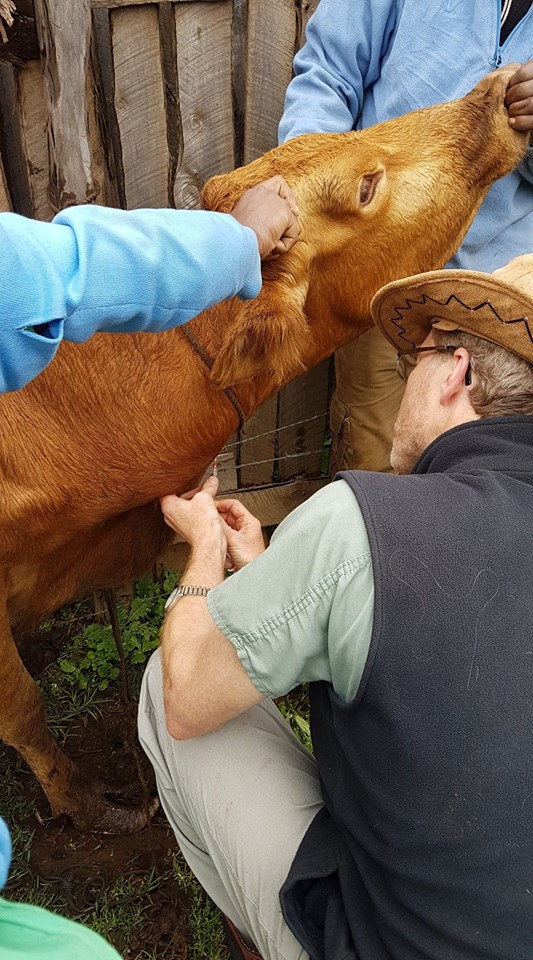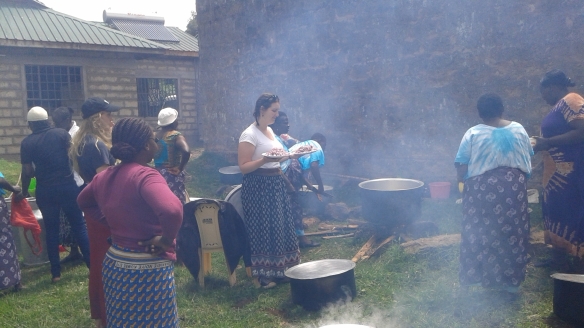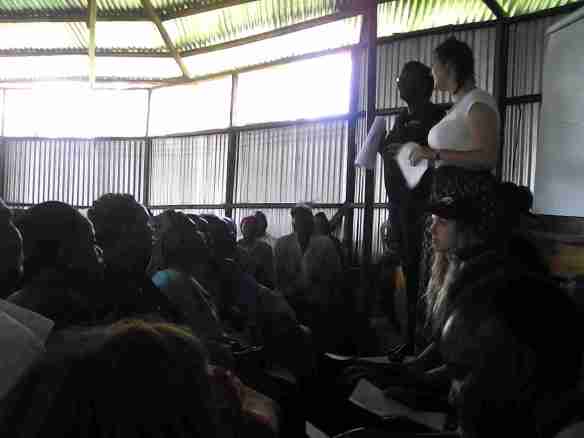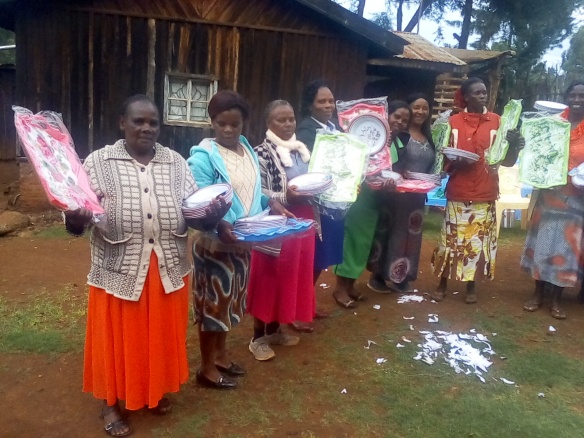15 August 2018
Jambo! Muuga! Hello!
It’s been some time since my last post, but not for lack of experiences to share! In fact, August seems to have brought us an entire summer’s worth of Kenyan culture in just a couple of weeks, and time truly has flown by. Keeping the stories brief will be a challenge (or else I may have you reading for hours), but I’ll do my best without having to sacrifice any awesome-ness.
First things first: THE SUN HAS RETURNED! Can you tell I’m in my glee? Applying sunscreen twice a day is a welcome change from zipping up my sweater and hiding under the hood. Of course, with this sun comes dry, dry, DRY dirt, leading to dusty scrubs, dusty hair, dusty hands, and undoubtedly, some fairly dusty lungs after travelling all day over the roads of Naari from farm to farm. We’ve learned that the rains won’t come again until October, so we’ve been happy to visit farmers who are preparing silage to feed their cows as less forage becomes able to be harvested in this dry season.
Next, on to the real excitement. If you were to ask me at the end of July how things were going, I would have had to admit my days were feeling slightly monotonous and I had begun to feel worn-out. I partially blame the poor weather, together with some happenings in Canada that left me wishing to be in Newfoundland. Thankfully, the universe pulled through with a pick-me-up the evening Boni called me to the kitchen and said, “Kendi, would you all like to attend a wedding?” Oh, would we ever! Who could pass that up!?

Picture 1: Where are the gumboots!? (left to right: Lee, Ashley, Remmy)
On August 5th, we all fancied up – our team almost unrecognizable without our scrubs and boots! – and visited nearby Isiolo, where Boni’s high school friend, Andrew, was marrying his lovely bride, Lydiah. We attended the ceremony in a Catholic church and while the service was primarily in Kiswahili, much of it was familiar to weddings at home – you know, reading Bible verses, speaking vows, singing hymns, taking Communion. The differences, however, were why we were there: The bridal party and groomsmen danced up the aisle! Children from the church congregation danced up the aisle! After the vows and the kiss, the bride and groom danced down the aisle! Everyone sang and shuffled in the congregation, while we four wazungu (“white people”) tried to keep the beat and absorb all that was happening. We completed the afternoon with a meal of nyama choma (“roasted meat”, Kenyan barbequed mbuzi, “goat”) and then pieces of wedding cake.

Picture 2: Visiting with Mama Josephat at Unity, a women’s village in Samburu (left to right: Ashley, Alexandra (VWB), Hannah, Mama Josephat, Aiyanna (VWB), Madi, Salome).
The next morning, joined by our friend Salome and two girls interning with Veterinarians Without Borders (VWB), we all piled back into a car to drive a bit farther north to Archer’s Post in Samburu County. Our mission for the day: visiting a women’s village called “Unity”. I was very fortunate to have been told about this village by a classmate, Rachael (doing equally awesome vet work this summer in Vietnam!), and was incredibly excited for an opportunity to learn about women-governing-women in the middle of such a patriarchal society. At the gate, we were delighted to be welcomed by song, dance, and giant, beautiful, beaded necklaces! I was in my glee! (The theme of today’s blog, apparently!) Following some group dancing and photos, we were welcomed by Mama Josephat* and given a history of Unity village – established in 2011 by half a dozen women, the village was built for those wishing to escape such challenges as oppression and domestic violence at home. Today, twenty-five women inhabit Unity, each with shared duties and responsibilities, all taking part in meetings several times a month, all with opinions and voices that can be expressed and heard.
In addition to learning about Unity, I took a moment to speak with a member of the village, Patricia, about the anti-FGM (female genital mutilation) movement. I was intrigued to learn about such a powerful push against such a deep-set and long-practiced tradition remaining in some parts of Kenya. Patricia explained to me that women in Unity do not practice FGM, and their daughters (like all girls in Kenya that are attending school) are taught that no one can force the practice upon them. I asked what has encouraged modern Kenyan women to move away from the practice, and was told that aside from health and well-being, women are becoming aware of the unfair standard set against them – in a culture where men can take multiple wives, women were traditionally “circumcised” as girls in order to be fit for marriage and as a means of preventing infidelity. Patricia explained that the practice “takes a woman’s feelings”, and that women are becoming more aware of the injustice being done to them. In Kenya, female genital mutilation has been outlawed, but as with any major paradigm shift, the change and acceptance of something “new” takes both time and an increase in education. I left the village happy to have had the opportunity to learn about these forms of women empowerment in Kenya, and all of the change, potential, and growth that is coming in this beautiful country.

Picture 3: Women in costume performing a traditional cultural “folkdance” at a Methodist Church women’s rally.
Only days after a fantastic weekend, we chanced upon learning of a Methodist Church women’s rally happening at a nearby school. In our scrubs and boots, we visited in the morning to catch some of the singing, and to happily be greeted by Beatrice (mom) and Jane (Gatwiri). More glee! The ladies invited us back for the afternoon so that we could take in the real fun – traditional dance! We squeezed in one more farm for the day then returned to costumes, color, song, and the most vibrant energy ever! And while I sat on the grass with Beatrice by my side, I had another feeling of “wow, I am actually in Africa”. Honestly, how I’ve gotten through this entire summer with only tearing-up once from the emotion of it all is truly a miracle.

Picture 4: Making fond memories with Magda and mandazi – two of my favorites from Kenya!
The cultural immersion continued even at our Kenyan home, when George taught me the recipe for mandazi, yummy thin pieces of bread fried in oil (that to my delight are very similar to fry-jacks, my favorite breakfast treat from last summer in Belize!), as well as how to make masala tea (“spiced tea”, what we are more familiar with as chai) – tastes of Kenya to compliment the music, the dancing, and the colors.

Picture 5. Delivering a seminar to all members of Naari Dairy, and to reach out especially to members who, due to time constraints, did not receive a visit from our team this summer.
And with that, we’ve reached our final day in Naari. Lee, Remmy, and I delivered a brief presentation to farmers of Naari Dairy to highlight the most common challenges and issues we encountered with them over the course of our internship – primarily issues of underfeeding dairy meal and minerals and how to accurately measure the weight of cattle to determine appropriate doses of deworming medicine. Inspired by calendars printed with nutritional messages (in Kimeru) that were distributed by the nutrition team and recognizing the limitations of our English handbooks, Lee drafted up a brief handout summarizing all of our advice that was then translated and given to attendees of the seminar. It was our wish that having the written information will help with their memory as well as the implementation of new practices, and will encourage farmers to share the knowledge with their neighbours.
The seminar ended with a grand surprise when members of the Dairy presented us with thank-you gifts: “Naari Dairy” shirts, plus lesos (colorful fabric worn tied around the waist, often printed with a border and a proverb) for the girls! IN MY GLEE. Later that evening, many of our new friends joined us for one last dinner and bittersweet “goodbyes”. The surprises continued as Mama Melissa* walked in carrying a black forest cake (my absolute fave! IN MY… well, I don’t really need to say it again, do I?), the decoration of “Farewell Friends” reminding us of how blessed and honored we’ve been to have found ourselves a family from across the globe.
 Picture 6. Being wrapped in a leso – what a beautiful farewell present!
Picture 6. Being wrapped in a leso – what a beautiful farewell present!
For one last time from Kenya, I send my love and hugs.
Ashley Kendi
*Kenyan mother’s are commonly referred to by the name of their eldest child. For example, “Mama Josephat” is named for her eldest son, Josephat, and we sometimes call our friend, Caroline, “Mama Melissa”.

 The vet team enjoying a cup of tea: Ashley, me, and Remmy
The vet team enjoying a cup of tea: Ashley, me, and Remmy





 Hannah (Makena) is always happiest with a good cup of coffee in hand.
Hannah (Makena) is always happiest with a good cup of coffee in hand. 

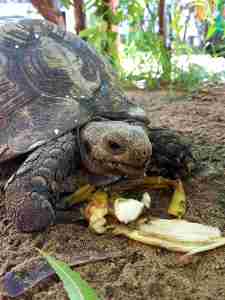
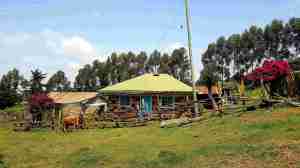
 “THE TEAM!” Attending some cases with Benard on a sunny day (we do see it sometimes), learning about common ailments of cows in Naari and how to treat them.
“THE TEAM!” Attending some cases with Benard on a sunny day (we do see it sometimes), learning about common ailments of cows in Naari and how to treat them.

















